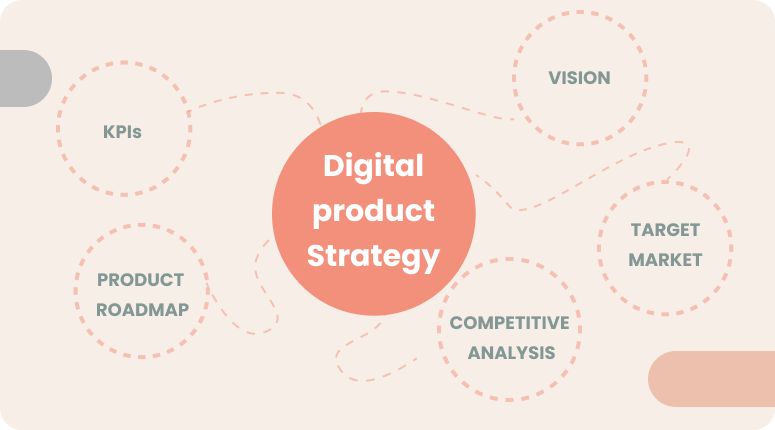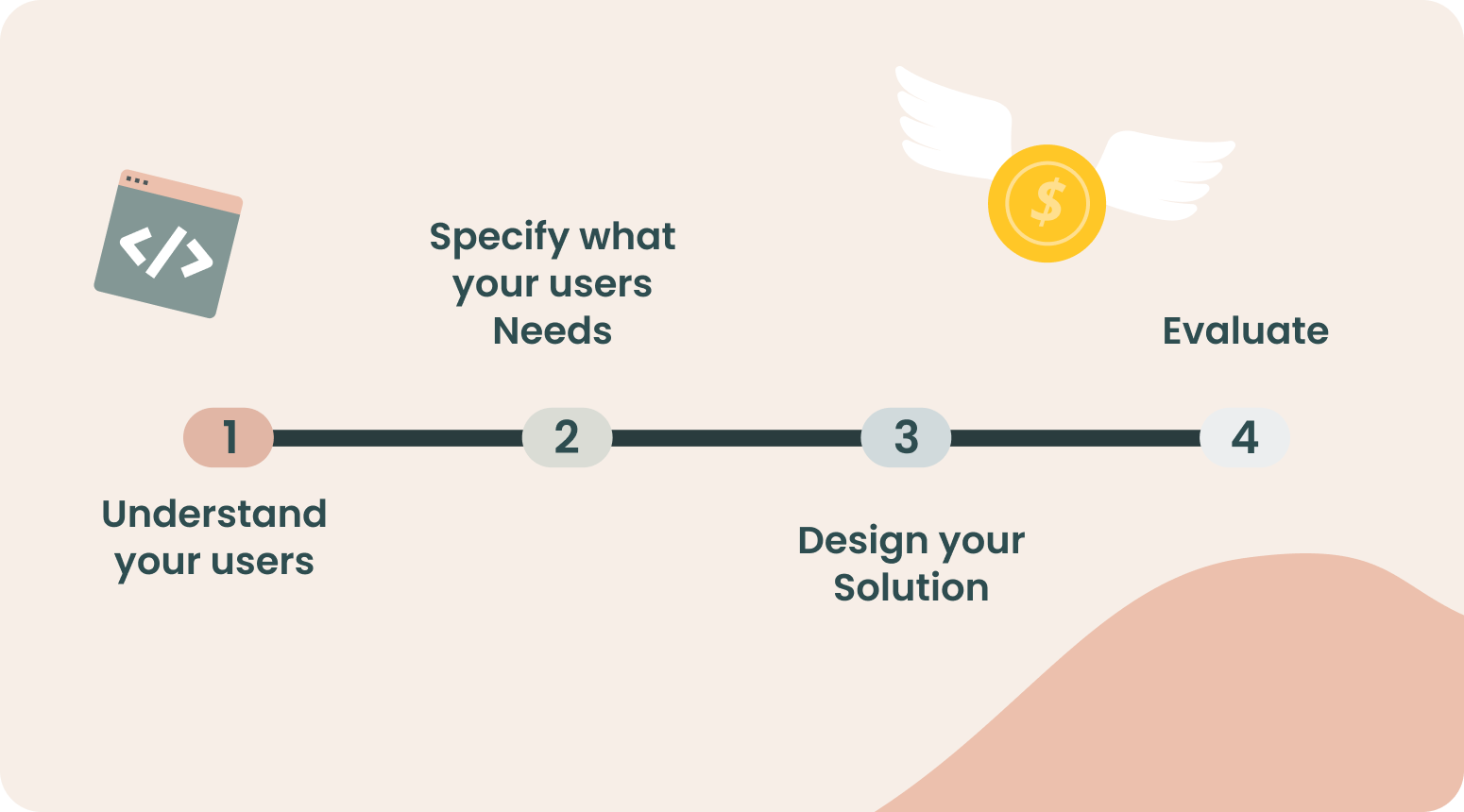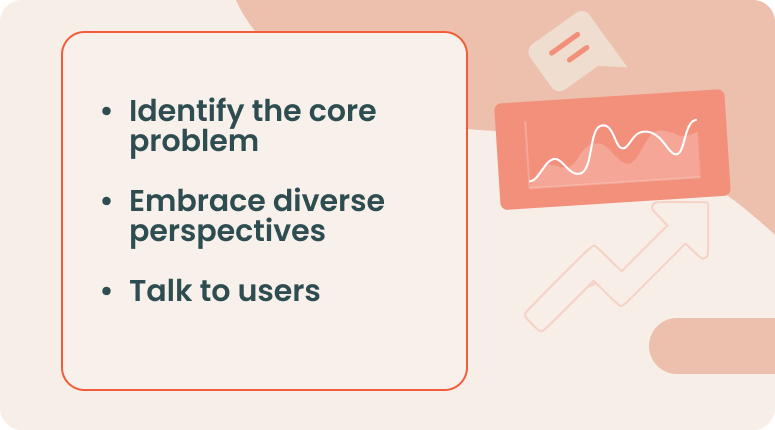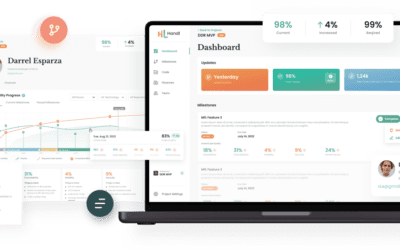There are many reasons a new digital product can flop. Among these, there is a particular reason that seems easy to avoid but is surprisingly common: many product creators fail to put users at the centre of the design process. They build what they think will work, without considering what their users actually need.
What does this mean?
Success hinges on a well-defined digital product strategy. This serves as a roadmap that ensures your product has a user-centred design approach: in that it aligns with user needs, addresses market demands, and ultimately achieves your business’s mission.
What is a Digital Product Strategy?

A digital product strategy is a comprehensive plan outlining the development, launch, and growth of a digital product. It encompasses several critical elements, including:
- Vision: A clear vision for your product, defining its purpose and value proposition to the target audience.
- Target Market: Identifying your ideal customer and understanding their needs and pain points and Challanges.
- Competitive Analysis: Assessing the landscape of existing solutions and identifying opportunities to set yourself apart from the competition.
- Product Roadmap: A high-level plan for product development, outlining key features and functionalities.
- Metrics and KPIs: Defining success metrics to track progress and measure the impact of your product.
How to Create a Digital Product Strategy
Creating a winning digital product strategy requires a user-centric approach. User-centred design (UCD) is an iterative process that relies heavily on design methods to gather user insights, translate them into solutions, and validate those solutions. These methods are strategically integrated throughout the key steps of UCD:

Step 1: Understand the Who, When, Why, and How of your users:
Do not rely on assumptions; conduct user research through interviews, surveys, and usability testing to uncover these details:
- Who: Demographics like age, location, occupation, and income.
- When: When and how often will users interact with your product? What is their typical context (e.g., commuting, working)?
- Why: What pain points or needs does your product address? What are their goals and motivations for using your product?
- How: How do users currently solve the specific problem you are trying to address?
Step 2: Specify what your users (and your business) needs:
Now that you understand your users, you have to conduct generative methods that translate their needs into actionable requirements, like brainstorming and persona creation. Brainstorming helps explore a wide range of solutions, while persona creation translates user research into actionable features that cater to specific user types. Based on the persona you have created identify the:
User Needs: Prioritise features based on user research and feedback. Consider both functional needs (specific features) and non-functional needs (usability, performance).
Business Needs: Align user needs with your business goals. How will your product generate revenue or achieve strategic objectives?
This ensures your product offers value to both users and your business, fostering long-term success.
Step 3: Design your solution:
Armed with the knowledge regarding your user and business needs, it is time to design your solution. This phase utilises generative methods to bring your user-centric solutions to life. User flows map out the user journey, while wireframes provide a low-fidelity blueprint of the interface. Clickable prototypes allow for initial testing and user feedback before committing to high-fidelity design. Here are two specific design methods that translate these user and business needs into a user-centred solution:
- User-Centred Design (UCD): Apply UCD principles to create an intuitive and user-friendly interface. This might involve user flows, wireframes, and clickable prototypes.
- Focus on Usability: Usability, on the other hand, is more narrowly focused on how easy and efficient it is for users to achieve their goals within a product. It does not focus on the entire user experience. Prioritise a seamless user experience that caters to your target audience’s needs and behaviours.
Step 4: Evaluate how well you met the requirements:
Testing is crucial for ensuring your product meets user and business requirements. Usability testing, a core investigative method, observes real users interacting with your prototype or product. This reveals usability issues and helps ensure your design effectively addresses user needs. To guarantee this, there are two types of rigorous testing the products have to go through:
- Internal Testing: Conduct usability testing with internal teams to identify any usability issues before launch.
- User Testing: Gather feedback from real users through usability testing and feedback sessions. This helps refine your product and ensure it addresses user needs effectively.
Remember, a digital product strategy is a repetitive process. Use the insights from evaluation to refine your product and roadmap, ensuring it stays aligned with user needs and market trends.
By strategically weaving investigative and generative design methods throughout the UCD process, you gain a deep understanding of your users, translate their needs into solutions and develop a digital product strategy that sets your product on the path to long-term success.
Digital Product Strategy: Toward a Strategic Growth Platform
A digital product strategy thrives if it has a clear and compelling vision. This vision serves as the guiding star for any product development and growth by going beyond simply describing features or functionalities. Think of the vision as the “why” behind the product, the reason it exists and the change it seeks to bring about.
The way toward achieving an ambitious vision comes with a roadmap in the form of a strategic growth platform, which outlines all you need to propel your product’s growth and success.
With change being a constant, a strategic growth platform becomes even more crucial because it fosters adaptability while ensuring that your product is on track toward long-term goals.
However, it is not set in stone, so you must be willing to be flexible and experimental. While gathering user data and marketing insights, prepare yourself to iterate and redefine your platform so that it remains effective in a dynamic setting.
Building a robust strategic growth platform is essential in transforming your digital product strategy from vision to reality.
Digital Product Strategy Example: The Healthweave App Redesign

User centric design
Healthweave, a chiropractic appointment scheduler app, exemplifies the power of a user-centric digital product strategy. Recognising the limitations of their initial app, they adopted a UCD approach. Through user research, they identified key pain points and desired features that they can implement:
Pain Points:
- Lack of exercise guidance between sessions, when patients might not know what exercises to do outside of their physiotherapy appointments.
- Lack of reminders to book the next sessions to help patients manage their appointments better.
Desired Features:
- Monitoring tools for pain level tracking to allow patients to track their progress and adjustments to their treatment plans
- Treatment effectiveness measurement to help patients understand how well their treatments are working and to provide valuable data for the therapist
- Recovery tools and equipment purchase options to provide patients with convenient access to tools that could help aid their recovery at home
- Nutritional planning integration to help manage diets and provide a more holistic approach to physiotherapy.
By incorporating features to address these pain points and desired elements from their users, Healthweave transformed their app into a holistic health hub, boosting user engagement and business success.
Healthweave showed that by focusing on the needs of their customers, benefits will follow for their business. In their case, the user-centric design is non-negotiable because they wanted an app that users will truly find useful, up to the point that they use it enough for it to become a regular habit, and also a business success.
By taking time to do their research and listening to the customers, they found ways to implement their findings to benefit everyone. After all, a great customer experience s is a win for your company, and Healthweave understood that.
How to Get Started with Strategic Planning

Feeling paralysed by the blank page of strategic planning? Here’s a practical 3-step guide to jumpstart your digital product strategy:
- Identify the Core Problem: Don’t get bogged down by solutions yet. Instead, start by framing your planning around a core user problem or challenge your product aims to address. What specific pain point are you passionate about solving? Focusing on a well-defined problem fosters a user-centric strategy.
- Embrace Diverse Perspectives: Assemble a strategic planning team so that you have different viewpoints about the strategy. Include marketing, sales, product development, and even customer support. This diversity ensures your strategy considers the user experience, business objectives, and market realities.
- Get Out of the Office (and Talk to Users): Strategic planning shouldn’t happen in a vacuum. Conduct user research to understand your target audience’s needs and behaviours. This might involve user interviews, surveys, or even shadowing users in their natural environment. By directly engaging with users, you’ll gather invaluable insights to inform your strategy.
These initial steps will propel you towards a user-centred and effective digital product strategy. Remember, strategic planning is an ongoing process. Be prepared to adapt your approach as you learn more about your users and the market landscape, or you can find a digital product strategy template to help you figure out your goals for your business.
Digital Product Strategy Assessment
Developing a winning digital product strategy doesn’t have to be overwhelming. There are many resources and guidelines that provide means of assessing your digital product strategy. Such as templates, guides and free consultations with software specialists. For example, Dazlab’s product readiness quiz assesses how prepared a particular product is for development. It starts by asking a series of questions that evaluate various aspects of the product, such as its validation, business metrics and team’s experience.
In essence, the assessment acts as a readiness check to gauge how well-prepared your product is before you start development.
By using a strategic planning tools like Dazlab’s product readiness quiz, you can develop a great digital product strategy that sets your product on a course for long-term success.
Conclusion:
The digital landscape is brimming with products, but only those who prioritise user needs truly thrive. By following a user-centric approach, you’ll gain better understanding of your target audience’s pain points and aspirations, which will help in the development of a product that offers real value and resonates with your users.
Remember, a successful digital product strategy is a roadmap, not a rigid destination. Embrace flexibility, continuously gather user feedback, and be prepared to adapt your strategy as you learn and grow.
Ready to get started? Contact us now.




